Abstract
Reticulocytes from newborn infants with Rh isoimmune hemolytic disease actively incorporated radioactive amino acids in vitro into hemoglobins F and A. Approximately 50% of the reticulocytes appeared capable of synthesis of both of these hemoglobins within the same cell, as demonstrated by the selective elution technique of Betke and Kleihauer. An isoleucine analogue, L-O-methylthreonine, inhibited the incorporation of a variety of amino acids into hemoglobin F, without significantly affecting the synthesis of hemoglobin A. The inhibition was prevented upon concomitant addition of L-isoleucine to the medium. These observations suggest that an independent biosynthetic apparatus is present in the cell for the synthesis of each of these two hemoglobins. Because isoleucine is present only in the gamma chains of hemoglobin F, the inhibitory effect of the analogue on the synthesis of this hemoglobin must represent a selective effect on the production of gamma chains.
Full text
PDF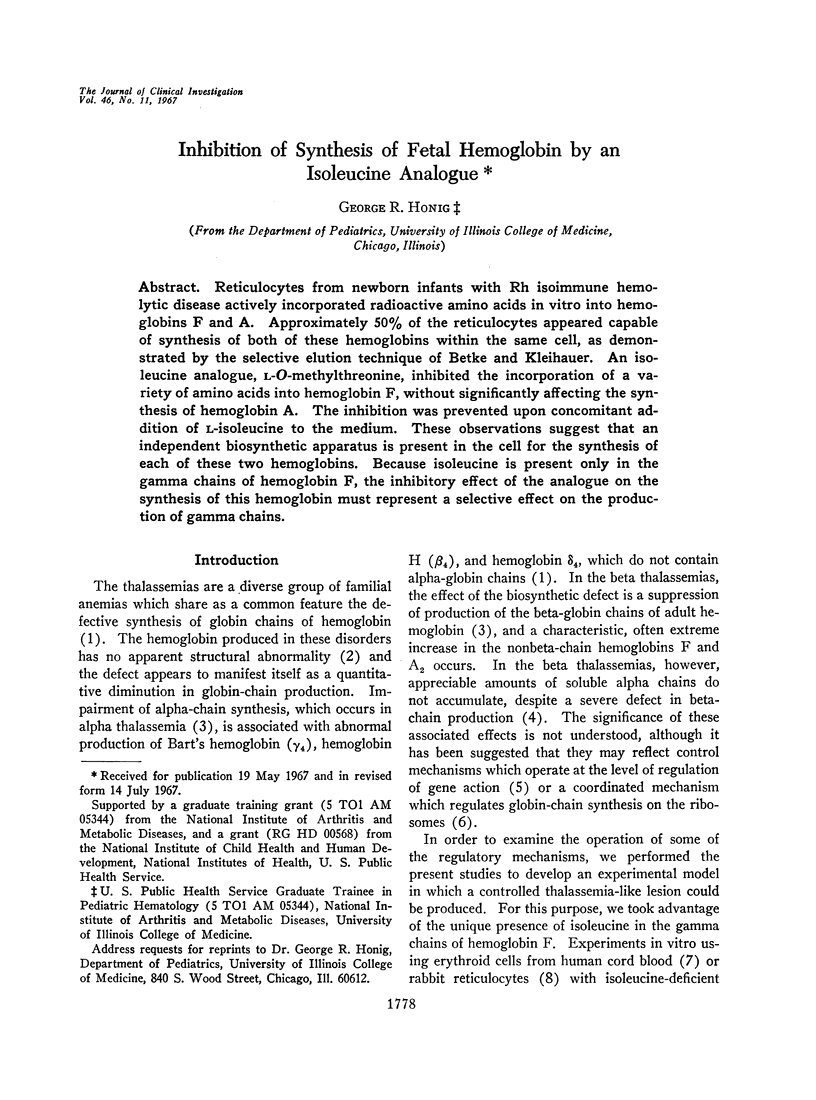
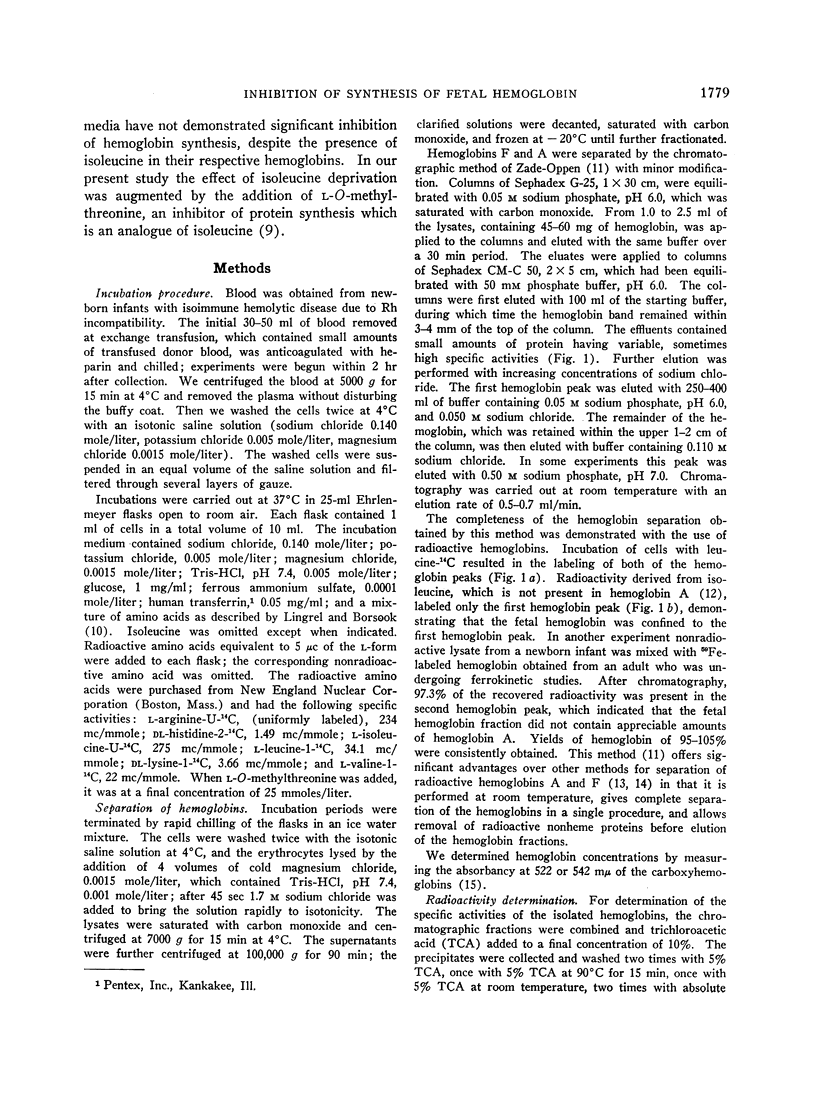
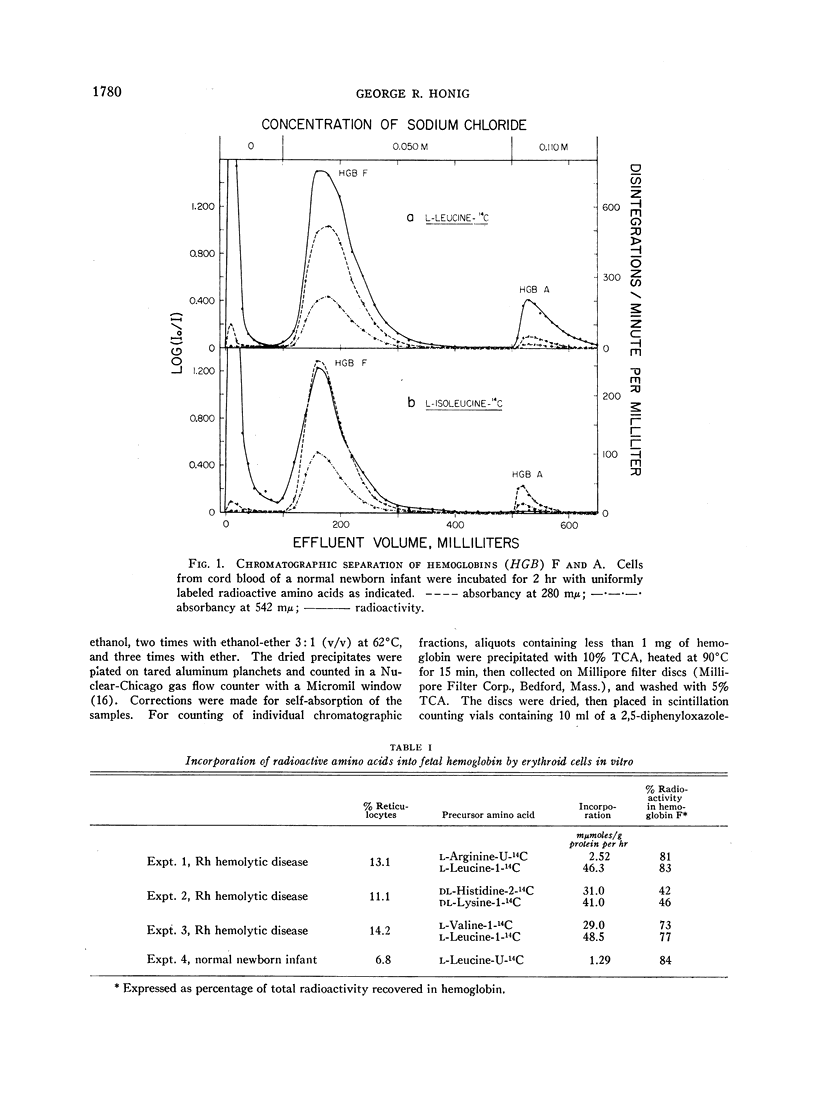
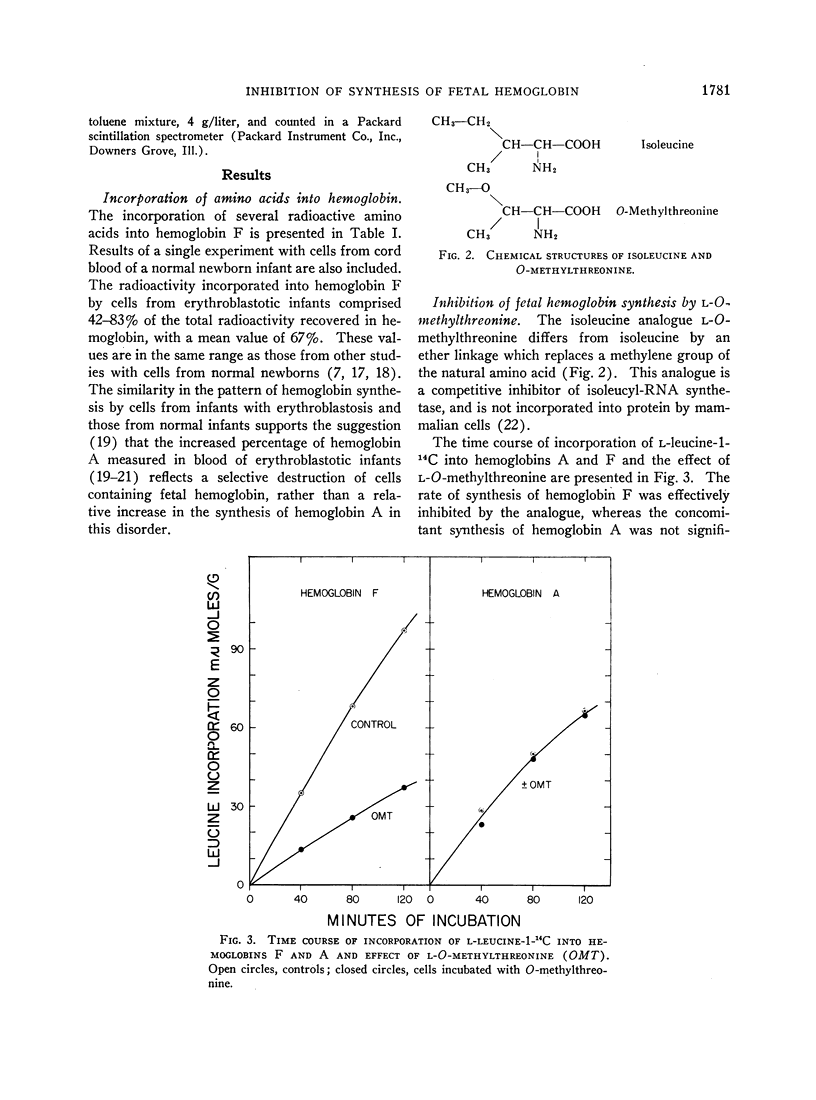
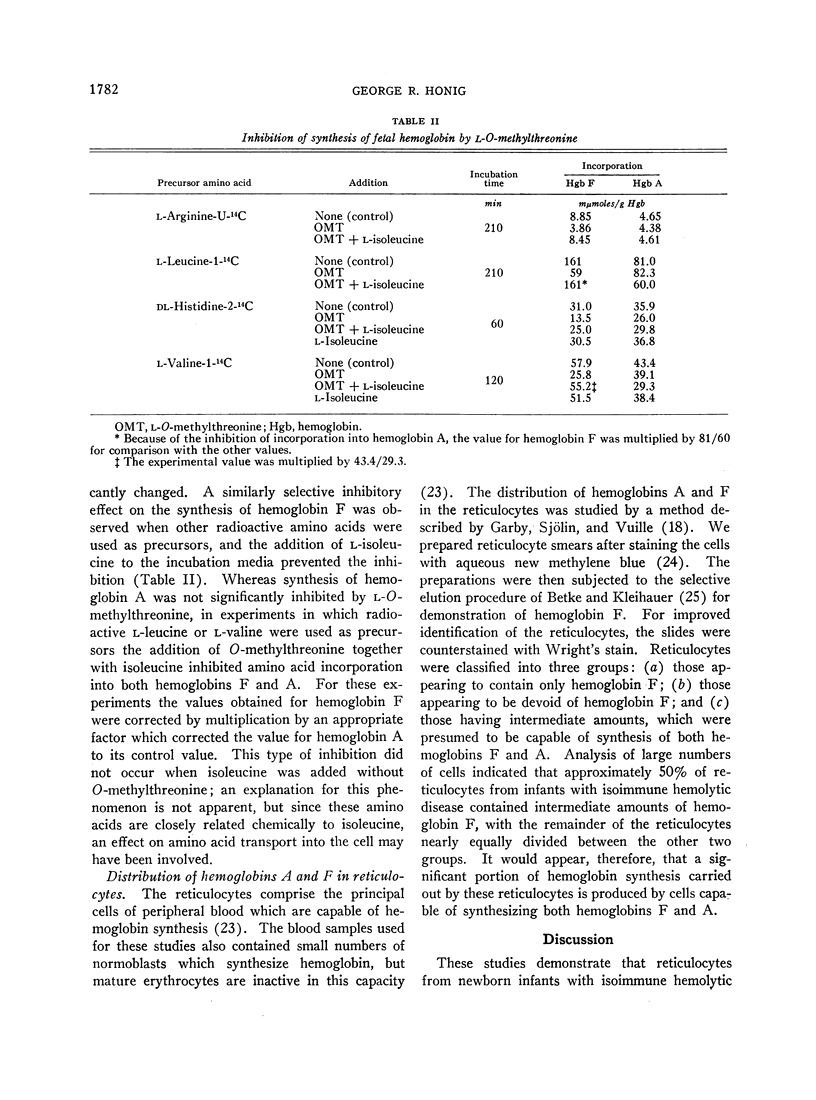
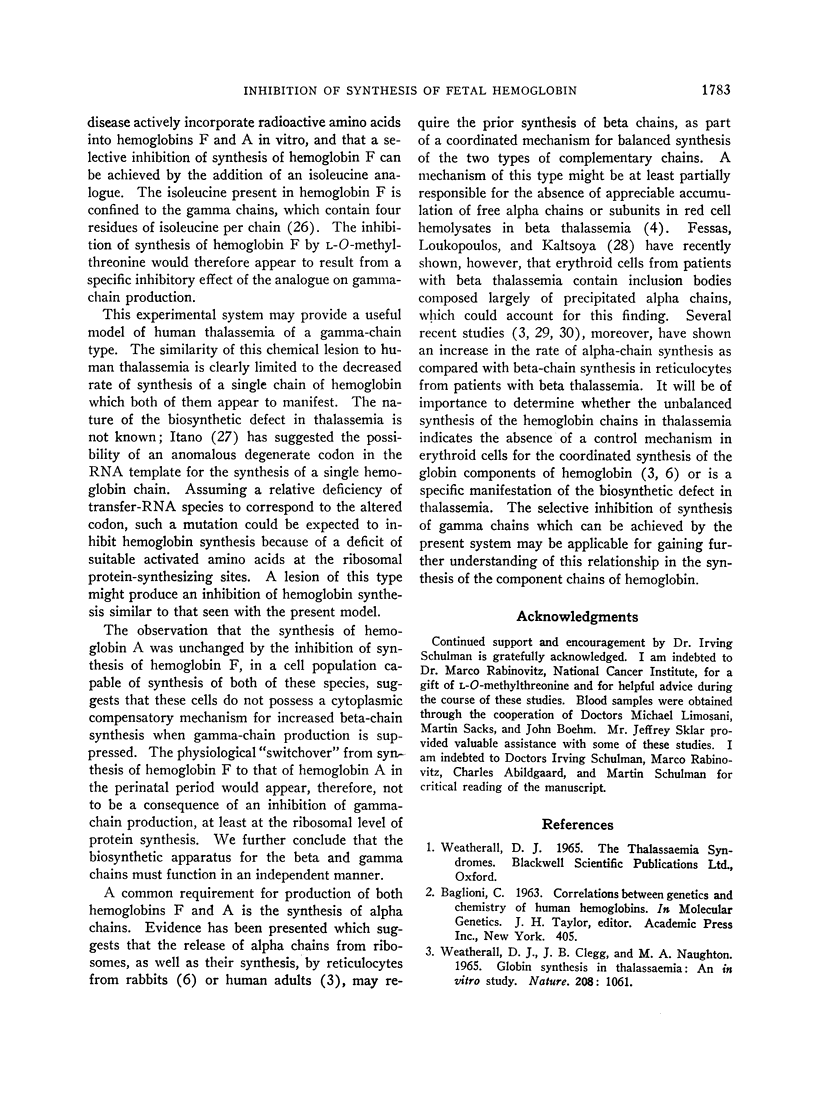
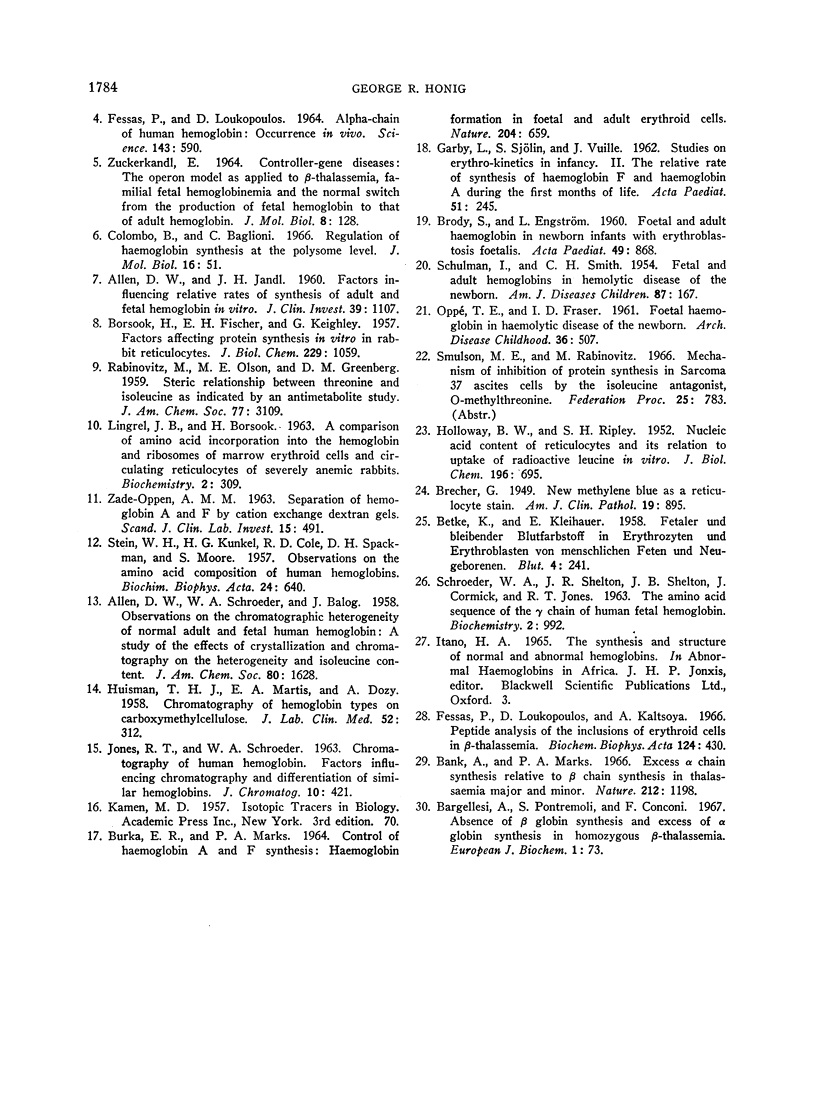
Selected References
These references are in PubMed. This may not be the complete list of references from this article.
- ALLEN D. W., JANDL J. H. Factors influencing relative rates of synthesis of adult and fetal hemoglobin in vitro. J Clin Invest. 1960 Jul;39:1107–1113. doi: 10.1172/JCI104125. [DOI] [PMC free article] [PubMed] [Google Scholar]
- BETKE K., KLEIHAUER E. Fetaler und bleibender Blutfarbstoff in Erythrozyten und Erythroblasten von menschlichen Feten und Neugeborenen. Blut. 1958 Nov;4(5):241–249. doi: 10.1007/BF01630321. [DOI] [PubMed] [Google Scholar]
- BORSOOK H., FISCHER E. H., KEIGHLEY G. Factors affecting protein synthesis in vitro in rabbit reticulocytes. J Biol Chem. 1957 Dec;229(2):1059–1070. [PubMed] [Google Scholar]
- BURKA E. R., MARKS P. A. CONTROL OF HAEMOGLOBIN A AND F SYNTHESIS: HAEMOGLOBIN FORMATION IN FOETAL AND ADULT ERYTHROID CELLS. Nature. 1964 Nov 14;204:659–661. doi: 10.1038/204659a0. [DOI] [PubMed] [Google Scholar]
- Bargellesi A., Pontremoli S., Conconi F. Absence of beta-globin synthesis and excess of alpha-globin synthesis in homozygous beta-thalassemia. Eur J Biochem. 1967 Mar;1(1):73–79. doi: 10.1007/978-3-662-25813-2_13. [DOI] [PubMed] [Google Scholar]
- Colombo B., Baglioni C. Regulation of haemoglobin synthesis at the polysome level. J Mol Biol. 1966 Mar;16(1):51–66. doi: 10.1016/s0022-2836(66)80262-0. [DOI] [PubMed] [Google Scholar]
- FESSAS P., LOUKOPOULOS D. ALPHA-CHAIN OF HUMAN HEMOGLOBIN: OCCURRENCE IN VIVO. Science. 1964 Feb 7;143(3606):590–591. doi: 10.1126/science.143.3606.590. [DOI] [PubMed] [Google Scholar]
- Fessas P., Loukopoulos D., Kaltsoya A. Peptide analysis of the inclusions of erythroid cells in beta-thalassemia. Biochim Biophys Acta. 1966 Aug 24;124(2):430–432. doi: 10.1016/0304-4165(66)90216-9. [DOI] [PubMed] [Google Scholar]
- GARBY L., SJOLIN S., VUILLE J. C. Studies on erythro-kinetics in infancy. II. The relative rate of synthesis of haemoglobin F and haemoglobin A during the first months of life. Acta Paediatr. 1962 May;51:245–254. doi: 10.1111/j.1651-2227.1962.tb06538.x. [DOI] [PubMed] [Google Scholar]
- HOLLOWAY B. W., RIPLEY S. H. Nucleic acid content of reticulocytes and its relation to uptake of radioactive leucine in vitro. J Biol Chem. 1952 May;196(2):695–701. [PubMed] [Google Scholar]
- HUISMAN T. H., MARTIS E. A., DOZY A. Chromatography of hemoglobin types on carboxymethylcellulose. J Lab Clin Med. 1958 Aug;52(2):312–327. [PubMed] [Google Scholar]
- OPPE T. E., FRASER I. D. Foetal haemoglobin in haemolytic disease of the newborn. Arch Dis Child. 1961 Oct;36:507–510. doi: 10.1136/adc.36.189.507. [DOI] [PMC free article] [PubMed] [Google Scholar]
- SCHROEDER W. A., SHELTON J. R., SHELTON J. B., CORMICK J., JONES R. T. THE AMINO ACID SEQUENCE OF THE GAMMA CHAIN OF HUMAN FETAL HEMOGLOBIN. Biochemistry. 1963 Sep-Oct;2:992–1008. doi: 10.1021/bi00905a016. [DOI] [PubMed] [Google Scholar]
- SCHULMAN I., SMITH C. H. Fetal and adult hemoglobins in hemolytic disease of the newborn. AMA Am J Dis Child. 1954 Feb;87(2):167–178. doi: 10.1001/archpedi.1954.02050090155003. [DOI] [PubMed] [Google Scholar]
- STEIN W. H., KUNKEL H. G., COLE R. D., SPACKMAN D. H., MOORE S. Observation on the amino acid composition of human hemoglobins. Biochim Biophys Acta. 1957 Jun;24(3):640–642. doi: 10.1016/0006-3002(57)90261-5. [DOI] [PubMed] [Google Scholar]
- Weatherall D. J., Clegg J. B., Naughton M. A. Globin synthesis in thalassaemia: an in vitro study. Nature. 1965 Dec 11;208(5015):1061–1065. doi: 10.1038/2081061a0. [DOI] [PubMed] [Google Scholar]
- ZADE-OPPEN A. M. SEPARATION OF HEMOGLOBIN A AND F BY CATION EXCHANGE DEXTRAN GELS. Scand J Clin Lab Invest. 1963;15:491–496. [PubMed] [Google Scholar]
- ZUCKERKANDL E. CONTROLLER-GENE DISEASES: THE OPERON MODEL AS APPLIED TO BETA-THALASSEMIA, FAMILIAL FETAL HEMOGLOBINEMIA AND THE NORMAL SWITCH FROM THE PRODUCTION OF FETAL HEMOGLOBIN TO THAT OF ADULT HEMOGLOBIN. J Mol Biol. 1964 Jan;8:128–147. doi: 10.1016/s0022-2836(64)80154-6. [DOI] [PubMed] [Google Scholar]


